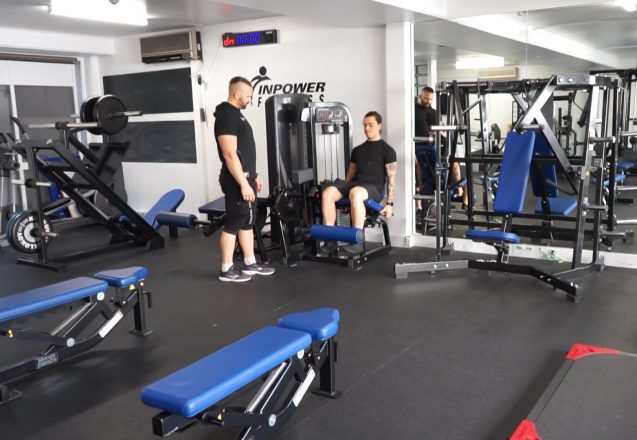Strength Training Technique for the Personal Trainer
Two of the hottest topics currently in the personal training and strength training field are periodization and overtraining. In the past, most training methods used by personal trainers came from the Iron Game. That is why in the recent past, and often now as well, over-zealous Pt’s design programs comprised of the Arnold Schwarzenegger blitz biceps workout, the bench press routine from Bill Kazmaier, and the Bulgarian pulling cycling. Then there was the periodization concept and Russia’s weightlifting system involving percentages progression. Fortunately, the current strength training field has progressed significantly over the last several years and has a lot to offer when it comes to program design for the Personal Trainer.
This article’s goal is to provide five steps to personal trainers to help athletes achieve a superior physical state by solving these problems:
– The syndrome of Wanting It All
– The debate over Specificity vs. General Strength
– Overtraining vs. undertraining
Step 1: Alternate Intensification Phases with Accumulation Phases
In order for your neuromuscular system to be forced into adapting to a certain training load, it is critical to plan variations in both the intensity and volume of the load. Since the body adapts quickly to the training load’s stress, after just two weeks, strength training programs start to lose their efficiency. This is our main philosophy for all of our personal training clients at Inpower Fitness
To maintain maximum neural activation, increases need to be maintained at progressively increasing levels or varied periodically. If the body is presented with the stimulus in the exactly same way every time, its efficiency will begin to diminish. In North America, unfortunately, not many strength coaches and personal trainers know about this concept. That is why less than optimal results are produced by their strength programs. To make fast progress, you need to alternate phases of unloading with high volume phases (extensive loading, accumulation).
Linear intensification is one of the common mistakes found in strength training programs, which is having ever-increasing intensity. For example, an athlete will proceed through a monthly program like the table below. This design has intensity with linear movement from 78 percent to 85, 90 up to a maximum of 95 percent.
Table 1: Strength development standard linea intensification training
Weeks 1-4 5-8 9-1 13-16
Sets 5 3 3 3
Reps 10 5 3 2
Intensity 75% 85% 90% 95%
Total reps 50 15 9 6
This type of program has a couple of different problems that can arise;
– The intensity climbs up continuously, which creates ever-increasing stress levels, and therefore not much time is allowed for regeneration.
– The same amount of hypertrophy that is achieved during the first training month cannot be maintained when sets of five or fewer repetitions are done. Why? Because volume is required for optimal increases in muscle mass.
An alternative solution is offered in Table 2 so that both the intensity and volume are presented in an undulatory manner. The volume in this example is reduced much more slowly and the intensity increases more gradually. Also, the phases are a lot shorter, which allows for the stimulus to be changed more frequently, which really helps with strength gains. The system is very popular with Canadian, West German, and Eastern European personal trainers.
Table 2: Alternating intensification and accumulation phases for strength development
Weeks 1-2 3-4 5-6 7-8 9-10 11-12
Sets 3 5 4 5 4 6
Reps 10-12 4-6 8-10 3-5 5-7 2-3
Intensity 70-75% 82-88% 75-78% 85-90% 80-85% 90-95%
Total Reps 30-36 20-30 32-40 15-25 20-28 12-18
Since linear overloading is not recommended, a much more rewarding alternative is offered by this undulatory approach. Schmidtbleicher states that strength potential is achieved more quickly when methods that favor muscle mass development are used first and then methods that favor the enhancement of motor unit activation (such as nervous system training).
Athletes must force their neuromuscular system to adapt through volume and then use intensity to stimulate it. This variety of training eliminates the psychological and physiological causes in training plateaus that come when specialization of intensity or volume is overemphasized. This allows for muscle mass and strength to be built at faster and higher rates.
Weightlifters need to focus on methods that will provide maximum neural activation increases. This can be seen in Yanko Rusev from Bulgaria. He won five World Championships, broke 25 world records, and won an Olympic gold medal in 1980. Rusev weighed 165 pounds and lifted 460 pounds.
Step 2. Vary the Types of Muscular Contraction
One of the most important factors in maximizing training response is to vary your strength training. Unfortunately, this training principle is often overlooked by personal trainers and strength coaches. Strength gains are achieved more quickly when many different kinds of contractions are used and not just one. A.K. Worobjow, a Soviet National Weightlifting coach, recommended the following percentages between the different kinds of contractions to achieve optimal strength development: 10 percent isometric, 20 percent eccentric, and 70 percent concentric.
Eccentric training makes it possible for athletes to achieve the highest muscular tension levels. This, in turn, greatly favors the development of strength and hypertrophy. It has been demonstrated many times that different combinations of eccentric and concentric training increase maximal strength more quickly than just using only concentric training. The following are some of the advantages offered by eccentric training:
– More muscle mass and strength gains can be induced compared to only isometric or concentric methods, which allows athletes to break through potential strength-gain plateaus.
— Fast eccentric work (plyometrics, for example) results in force-time curves shifting to the left which results in higher force development rates.
– Due to the very high loads that eccentric training uses, like the maximal weight methods, the nervous system is impacted in addition to the muscles.
– There are various forms that eccentric training may take, including the loading pattern below on an accumulation phase:
1. 4-6 sets of 4-6 reps each at 110-120%, 8 to 10 seconds eccentric, rest for 4 to 5 minutes in contrast between sets. This loading pattern could be followed by an intensification phased eccentric workout: 1. 1-2 sets of 3 reps each at 125%, with 3-5 seconds of eccentric, and then rest 4-5 minutes.
2. 1-2 sets of 3 reps each at 132.5%, 3-5 seconds eccentric, and then rest for 4-5 minutes.
3. 1-2 sets of 2-3 reps each at 140%, 3-5 seconds eccentric, and then rest for 4-5 minutes.
– Specially designed equipment like eccentric hooks can be used to increase eccentric loads.
Once a conventional concentric 4 to 6 RM set at 80-82 percent of 1 RM is complete, you can perform additional eccentric work by 25-30 percent extra weight being added on the barbell for the concentric training and then doing extra eccentric-only reps. Or instead of adding extra weight, resistance can be applied manually by a personal trainer (like pushing down on your barbell while you are performing a bench press) while you are doing the eccentric part of the lift. The extra negative reps exhaust levels of eccentric strength after concentric muscular failure is achieved. The method applies to the accumulation phase more, since this is where you want to achieve strength gains from hypertrophy. However, injuries can occur if the athlete does not control the descent of their chosen resistance.
Although eccentric training shows a lot of potential for improving strength, personal trainers should follow the guidelines outlined below:
– It should be practiced only after achieving a solid base on your strength training for one or two years.
– This kind of training has high muscle soreness levels associated with. Therefore, training frequency using this method should be limited to once every 7 to 10 days. The potential to overtrain can be increased by eccentric training and therefore it should be used sparingly. During competitive seasons it is also not recommended since it can hamper recovery time significantly.
– Slow eccentric training is associated with reducing the force development rate. This suggests that it mainly should be used during the off-season (preparation period), while you should do fast eccentric training during competitive seasons (pre-season and in-season).
– It frequently requires special equipment or assistance from one or two workout partners to help with moving resistance throughout the concentric range. During squats or other weight training exercises, eccentric training can be hazardous if the spotters have not been trained properly.
— Isometric contractions tend to be more specific in such sports as gymnastics and wrestling than they are to soccer or football, but they can also be used in predictor lifts to break through any strength gain plateaus. Since isometric contractions can produce 10-15 percent higher force levels, this type of workout can be used periodically to favor strength level growth. The following are examples of how isometric contractions can be focused on:
a) Functional isometric contractions can be performed by athletes after the muscle has been pre-fatigued by performing 4 to 6 partial reps. This method requires a power rack. After warming up, the athlete can choose a weight and move from one pin set to another, such as from the midpoint to six inches prior to lockout while performing a bench press. At the end of the final concentration repetition, perform 4-6 RM, contract isometrically for 6-8 seconds with maximum tension on the top pins. Lower your barbell and try to do another repetition. If another rep can be performed, that means the weight is not heavy enough.
b) The duration and intensity of a conventional set conducted to concentric muscular failure can be prolonged by isometric work. If an athlete has completed his final concentric part of a 6 RM barbell curls set. The barbell should be lowered by 30 degrees, stop for eight seconds, and then repeat this process at two different other angles.
c) Isometric stops may be incorporated into a movement’s dynamic range. For example, you can perform 6-second holds at different parts of a clean pull: at mid-thigh, right under the knee, and two inches off of the floor.
You can achieve eccentric overload by a personal trainer applying manual resistance to your barbell during the exercise’s lowering phase.
Step 3: Strengthen All Force-Velocity Curve Aspects
There are conflicting theories in North America on what the optimal speed is for performing strength work. One school of thought thinks that high-velocity training is best, while the other school claims that optimal strength gains can only be achieved through performing repetitions slowly only. Both of these schools of thought are right! Muscle gains occur more quickly if training is done at various speeds compared to if the training is always done at the same speed.
Another important thing to understand is that the contraction has a certain training effect on the body’s neuromuscular system. When high loads are moved at slow speed this eliminates using momentum to lift resistance. There is a definite advantage to training at a slow speed compared to high-speed lifting when it comes to developing maximum strength. When the movement is slowed down (3-10 seconds for every eccentric phase) it augments both the tensions levels that are imposed on the muscles and the duration of how long the stimulus lasts. It favors faster tension developed that is imposed on the muscles which result in faster development of muscle mass and strength.
When training is performed at slow speeds, 60 seconds of work maximum should be done for each set. For example, when the speed of movement is reduced to the point where each eccentric and concentric part of the lift takes 6 seconds, a maximum of 5 repetitions should be performed per set [5 repetitions x (6 seconds eccentric + 6 seconds concentric) = 60 seconds].
The force-time curve is raised when you train at slow speeds, while it is shifted to the left when training is done at high speeds. Training explosively at higher loads doesn’t generate high strength increases. However, it is very beneficial for training the nervous system to generate a positive adaptation to the force development rate. The early portion of force development is emphasized for these reasons: (a) it is beneficial for synchronization, and (b) for practical purposes is relevant since there is a very short time available in athletic activities for the muscles to contract.
Execution done at a slow velocity is associated with producing high forces. High-velocity movements, by contrast, favor high neuromuscular output levels. Therefore, a weight light enough to use for power training isn’t heavy enough to use for strength training. However, for the first year of strength training for an athlete, it is recommended by European strength coaches is to use moderate (60 degrees per second) or slow (30 degrees per second) execution tempos.
Although high-speed strength training is specific to fast movements that are performed in such sports as soccer and football, it needs to be done only after a solid maximal strength base has been obtained. It is best to use slow movements to obtain a solid maximal strength base. Therefore, movements during the general preparatory phase need to be slow or moderate tempo using a variety of different contractions, with the movements being gradually sped up as it gets closer to the competitive seasons to specifically train the body’s nervous system.
Step 4. Use a Wide Range of Exercises
Another way to achieve strength more quickly and eliminate boredom at the same time is to change the form and nature of the exercise. Furthermore, only varying your strength training program’s intensity and volume is not sufficient to obtain optimal results. That is because while a given movement is being performed, the motor units’ order of recruitment for a muscle is fixed, even when there is a change in speed of contraction and force development rate. However, it is possible to change the recruitment order by shifting the body’s position or performing different movements for multi-functional muscles.
Certain motor units inside a muscle have a high recruitment threshold on exercise Y and a low recruitment threshold on exercise X. This recruitment order variation might be partly responsible for the training specificity that has been seen. It might also support the idea that bodybuilders have held for a long time that a muscle’s full development is only possible when movements are trained.
Strength coaches and personal trainers have a wide range of different strength training exercises that are available to them. For example, exercises that strengthen the knee and hip extensors may be performed using different training implements (machines, iron circles, trap bars, dumbbells, or Olympic bars). Also, you can change the starting positions on certain exercises. For example, a football lineman who performs clean pulls for improving his knee and hip extension power can be done from mid-thigh, from the hang, from the blocks, from the floor, on a podium, and so forth.
A great form of training is a partial range of movement that is definitely not used enough. Strength and conditioning coaches, for example, know that a great deal of weight may be handled from the lockout position in squatting and pressing exercises. However, the resistance required for performing full-range exercises is not enough for the strong points within the strength curve to be overloaded and why power rack training is so useful. When a power rack is used, certain parts of the range of motion can be selected by the athlete and optimal loads can be used for these ranges of motion. Bocks of different heights may be used to perform the numerous variations of Olympic lifts.
One challenging training stimulus can be to change the grip’s diameter. Try to perform curls or chins with oversize bars to produce a new type of training effect on the elbow flexors. Plastic pipe, foam, tape, or a combination may be used to thicken the bars.
When the exercises are varied using the methods above it will also make sure the athlete achieves strength in all movement planes. Athletes are often overly concerned with “Big Bench.” Instead, be good in all press formed and have a shoulder structure where a force can be applied from any angle. This approach can allow athletes to achieve the “Big Bench” more quickly to prevent boredom and reduce the risk of developing overuse injuries.
One way that variety in training can be ensured is to change your body position, like lifting your hips while performing a leg extension.
Step 5. Don’t Pay Attention to Percentages
Strength training programs often follow a system that uses different maximum percentages. There are serious drawbacks to this method:
– Over one day strength varies 10 to 20 percent. Therefore, if 1 RM is tested at 5 pm, the percentage that is prescribed for an exercise that is performed at 11 am may not be appropriate.
– Although the relationships between submaximal loads and 1 RM has been established fairly precisely, individual differences caused by fiber typing and neural factor can deviate a great deal. For example, although most people can normally perform 11 to 12 reps at 70 percent of 1 RM, one person on Canada’s National Judo Team can perform 24 reps at that percentage.
– The percentage relationship that is between the submaximal and maximum reps is different for each muscle. Research has shown that at 60 percent maximum, just 11 leg curl reps can be performed, while 40 leg press reps can often be done.
– Percentages do not leave room for any individual training responses. There are some gifted people who respond fast to a strength training program and using fixed percentages may undertrain them, while those same percentages may overstress other people. The latter kind of individual may be tempted to cheat in order to get the prescribed number of reps done at a certain percentage to keep up with their friends. Or if the person doesn’t cheat, they may become discouraged if they are unable to keep up with their friends. Another important factor is that athletes have different recovery abilities. So what can be done instead? Allow the load to be dictated by the reps instead of the other way around. This can be achieved by an intensity zone spread being used that is controlled by doing a fixed number of reps (like 6-8).
So if an athlete is in a certain stage where they perform 4-5 repetitions if 7 repetitions or more can be performed, that means their weight is too light and on the next set should be increased. If only 3 reps can be done by the athlete, then the weight is too heavy. In that way, the duration of the stimulus that is imposed on the muscle will at least be controlled. And since the contraction’s intensity is inversely proportionate to the stimulus’s duration, you will know about what intensity levels athletes are working at. Also, since multiple sets are conducted, optimal resistance can be individualized for each athlete on a certain day. Your training program can take such factors into account as the time of day.
Your athletes should fill out a personal training diary and also fill out a training station dairy at each lifting station. The diary will let you assess your program’s effectiveness since you can compare an athlete against others as well as against himself.
Percentage method proponents argue this prevents overtraining. Maybe, but why do 5 sets of 5 reps at 70 percent when 12 reps can be performed at that percentage? If overtraining is something you are concerned with, you can cut back on the number of exercises or sets. Your body is capable of protecting itself against work intensity, but not against work volume. Why waste a set as a warm-up?
The percentage relationship that exists between the submaximal and maximum repetitions will depend on the exercises that are performed and the muscle groups that are recruited. For example, more repetitions can be done at a certain percentage of the 1 RM of an athlete when performing the leg press compared to when doing leg curls.
Final Thoughts
There are numerous ways that workouts can be varied in a progressive and logical way to improve athletic fitness. You need to design strength training workouts for athletes while taking into consideration all of the different factors that affect the design of the program including recovery time, equipment, and training age. This is a must if you are a personal trainer.
When variety is incorporated into your workouts by making use of the steps that have been discussed in this article, it can do amazing things for your training program.
Variety is truly the spice, and there certainly is no good reason why a little bit of spice should not be added to your training programs. So do not hesitate to innovate, and do not train just to train. Instead, train to win!










